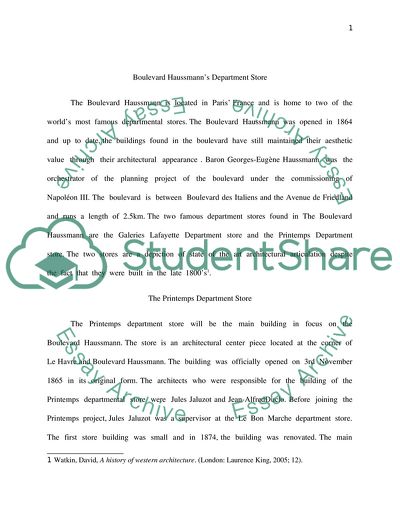Cite this document
(Boulevard Haussman's Department Store and Boulevard Des Capucines's Opera House Essay Example | Topics and Well Written Essays - 2000 words - 1, n.d.)
Boulevard Haussman's Department Store and Boulevard Des Capucines's Opera House Essay Example | Topics and Well Written Essays - 2000 words - 1. https://studentshare.org/architecture/1786796-boulevard-haussmans-department-store-and-boulevard-des-capuciness-opera-house-as-two-key-elements-in-the-haussmannization-of-parisian-architecture
Boulevard Haussman's Department Store and Boulevard Des Capucines's Opera House Essay Example | Topics and Well Written Essays - 2000 words - 1. https://studentshare.org/architecture/1786796-boulevard-haussmans-department-store-and-boulevard-des-capuciness-opera-house-as-two-key-elements-in-the-haussmannization-of-parisian-architecture
(Boulevard Haussman's Department Store and Boulevard Des Capucines'S Opera House Essay Example | Topics and Well Written Essays - 2000 Words - 1)
Boulevard Haussman's Department Store and Boulevard Des Capucines'S Opera House Essay Example | Topics and Well Written Essays - 2000 Words - 1. https://studentshare.org/architecture/1786796-boulevard-haussmans-department-store-and-boulevard-des-capuciness-opera-house-as-two-key-elements-in-the-haussmannization-of-parisian-architecture.
Boulevard Haussman's Department Store and Boulevard Des Capucines'S Opera House Essay Example | Topics and Well Written Essays - 2000 Words - 1. https://studentshare.org/architecture/1786796-boulevard-haussmans-department-store-and-boulevard-des-capuciness-opera-house-as-two-key-elements-in-the-haussmannization-of-parisian-architecture.
“Boulevard Haussman's Department Store and Boulevard Des Capucines'S Opera House Essay Example | Topics and Well Written Essays - 2000 Words - 1”. https://studentshare.org/architecture/1786796-boulevard-haussmans-department-store-and-boulevard-des-capuciness-opera-house-as-two-key-elements-in-the-haussmannization-of-parisian-architecture.


